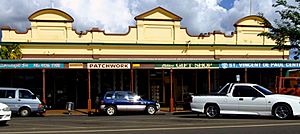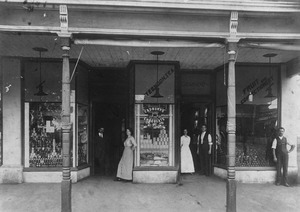Shops and Cafe, Childers facts for kids
Quick facts for kids Shops and Cafe, Childers |
|
|---|---|

Shops and Cafe, 2008
|
|
| Location | 54-58 Churchill Street, Childers, Bundaberg Region, Queensland, Australia |
| Design period | 1900 - 1914 (early 20th century) |
| Built | c. 1912 - 1930s |
| Architect | F H Faircloth |
| Official name: Shops and Cafe 54-58 Churchill Street | |
| Type | state heritage (built) |
| Designated | 21 October 1992 |
| Reference no. | 600612 |
| Significant period | 1910s, 1930s (fabric) 1912-ongoing (cafe historical use) 1930s-1950s (bank use) 1930s-1980s (news |
| Significant components | strong room |
| Lua error in Module:Location_map at line 420: attempt to index field 'wikibase' (a nil value). | |
The Shops and Cafe building at 54–58 Churchill Street in Childers is a special row of shops. It is listed on the Queensland Heritage Register because of its important history. The building was designed by F H Faircloth and built around 1912 to the 1930s. It shows how Childers grew as a town.
Contents
A Look Back: The History of the Shops and Cafe
The building at 54–58 Churchill Street has three shops and a cafe. It was built around 1912 for local farmers Robert Gant and William Brand. This building is in the main street of Childers.
How Childers Town Began
Childers started as a small town because of a railway line. The railway opened in 1887 to help with logging in the nearby Isis Scrub. By 1903, Childers became the main town for a rich sugar-growing area. Many sugar mills were built there.
The town had a large number of workers, especially during harvest time. Some of these workers were Kanaka labourers, who helped cut the sugar cane. Later, machines did more of the work, and the town's population became smaller. In the 1980s, Childers became known as a "heritage town." Many buildings on its main street were protected for their history.
The Big Fire and Rebuilding
Childers was planned differently from many other towns. It was set up as a private town, not by the government. In the 1890s, the main street was divided into smaller plots of land. The land where these shops stand was bought by William Thompson and Robert Dinnie in 1895.
By 1900, a wooden shop, possibly called Cocking's store, was on this spot. In March 1902, a big fire destroyed many shops on the south side of Childers' main street. Most of these were rebuilt with strong brick or stone. Luckily, the wooden shop on this site was saved from the fire.
New Owners and a New Building
In 1908, Robert Gant and William Brand bought the property. By 1912, the old wooden shop was replaced. The new building was made of masonry (brick or stone). It is believed that Bundaberg architect F.H. Faircloth designed it. He designed many new buildings in Childers after the 1902 fire.
The property was then divided. Gant and Brand kept numbers 54 and 56. Number 58, which became the Marble Cafe, was bought by John Comino.
The Comino Family and the Marble Cafe
The Comino brothers, John, Paul, George, and Arthur, came to Childers from a Greek island in the early 1900s. They started a fruit and refreshment business. The Marble Cafe was set up in the new building built by Gant and Brand.
The cafe was a fruit shop, a place to buy drinks, and a cafe. It served the many workers from the sugar farms. The cafe had beautiful silky oak furniture and tables with real Italian marble tops. That's how it got its name! Paul Comino ran the cafe until he passed away in 1978.
Other Shops and Businesses
Numbers 54 and 56 stayed with Gant and Brand's families until 1959. It's thought that by the 1930s, this part of the building had three separate shops. For twenty years, starting in the early 1930s, part of number 56 was rented by the Union Bank of Australia Ltd (now ANZ Bank).
Some changes were made around this time. Bars were put over the bank windows. A glass shop front was added to the shop next door. The awning (the cover over the footpath) was also updated. Other businesses included a tailor, A. Crossley (at 54), and the local newspaper, the Isis Recorder (at 56). The newspaper stayed there until the 1980s. More recently, shop 54 was used as an office for local politicians.
Since 1959, the Comino family has owned all four parts of the building. Today, the shops are used by a florist (54), St Vincent de Paul (56), a dress shop (56), and the Marble Cafe (58).
What the Shops and Cafe Building Looks Like
The building at 54-58 Churchill Street is a single-story building made of masonry (brick or stone) with a rendered (smooth plaster) finish. It has pitched roofs made of corrugated iron. Even though there are four different shops inside, they look like one building from the outside. They share a common parapet (the low wall at the top) and an awning (the cover over the footpath).
This building looks similar to other old shops on Churchill Street. It sits on a curved part of the street, making the town look very pretty.
Unique Shopfronts
The shops have different layouts inside. Number 54 is a small shop with one display window. Number 56 has two shops: a former bank, which is larger, and a narrower shop with two display windows. Number 58 is a large cafe with two entrances and three display windows.
The front of the building has a strong parapet and a flat metal awning. The awning is held up by wooden posts with unique bases. The ceiling of the awning is made of pressed metal with beautiful flower patterns. The parapet at the front has three special panels with arches and triangles at the top.
Inside the Shops
The building has lovely, original display windows. They have delicate wooden trim around large glass panels. The entrances are set back from the street and have double wooden doors. Number 58 has two columns inside that support a central area. Numbers 58 and one of the shops at 56 still have their original glass panels at the back of the display windows. The old bank at 56 has barred rectangular windows with white plaster frames.
Number 58, the cafe, has a large and impressive space inside. It has a high wooden ceiling with metal decorations. There's a rectangular skylight in the middle that lets in light. At the back, there's a wooden "clubroom." The shop at 56 has a flat wooden ceiling with several funnel-shaped skylights that are now covered. The old bank at 56 also has a wooden ceiling and a strong room made of concrete, which is no longer used. All the shops have floors with a diamond pattern made of ceramic tiles.
The Shops and Cafe building has a beautiful front, awning, and shopfronts. The inside of the cafe (No. 58) is especially impressive. The other interiors still show what they were used for in the past. This building adds a lot to the charming look of Churchill Street.
Why This Place is Important
The Shops and Cafe at 54-58 Churchill Street in Childers was added to the Queensland Heritage Register on 21 October 1992. This means it's a very important historical site.
A Glimpse into Queensland's Past
This building, built around 1912, helps us understand Queensland's history. It shows how Childers grew into a successful town in the early 1900s because of its timber and sugar industries. It also shows how the main street was rebuilt after the big fire in the early 1900s.
A Great Example of Old Commercial Buildings
The building is a good example of what commercial buildings in country towns looked like in the early 1900s. You can see this in its parapets, awnings, shop fronts, and overall design. It also shows the specific style, size, and materials used for buildings in Childers at that time.
Beautiful Design and Townscape
Many people in Childers and visitors value the building for its beauty. The cafe (No. 58) has impressive features like its open space, exposed roof beams, and skylight. The fine decorative front, awning, and shopfronts are also beautiful. The building fits perfectly with the other historic buildings on Churchill Street, making the whole street look lovely and old-fashioned.
Connections to Important People and Groups
This place has special links to the Comino family, who were Greek immigrants and important traders in the area. It also has a connection to the local newspaper, the Isis Recorder. Finally, it's an example of the work of F.H. Faircloth, a well-known architect from Bundaberg.


